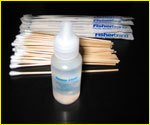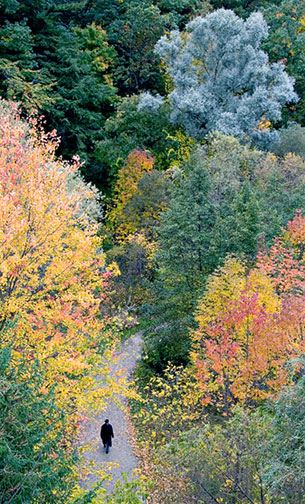
A 100% Clean Sensor!!
The biggest hassle for photographers using digital SLRs is dust and crud on the sensor. Dust has always been a problem for photographers, dating back to the Daguerreotype of 150 years ago. But with dust on sensors photographers have an additional problem. Cleaning them is almost universally warned against by camera makers. If you do so, and manage to scratch or otherwise damage the cover glass over the sensor, you are responsible for the cost of repairs. And even though the cover glass (which all sensors have) isn’t the sensor itself, in almost all cases it is bonded to the sensor, and thus scratches on its surface likely means an expensive replacement of the entire sensor module.
The solution that manufacturers offer is that you can send your camera in to be cleaned. This is pathetic advice for two reasons. When working in dusty and dirty conditions, and changing lenses often, sensors need to be cleaned every day. Even under less arduous conditions, it’s usually necessary to clean them every few days of use, and certainly when the inevitable blob appears in the beautiful clear sky that you’ve just shot. So, sending the camera in to be cleaned is simply an unrealistic, and actually risible suggestion.
Worse than that are the reports that I constantly hear from photographers who have sent their cameras in for cleaning, only to find them returned every dirtier than when they were sent off.
The other alternative is to do it yourself. I have writtenan articleon the subject, and also produced an in-depth video segment on it, which appears inIssue #10 of The Video Journal. (It should be mentioned that the Olympus E-1 is unique at the moment in having an ultrasonic sensor vibration capability which, I am told, does a very good job of shaking dust from the sensor).
The tools that I recommend for do-it-yourself sensor cleaning, in both the article and video, are the ones that I have been using myself till now. This includesEclipse Fluid,andSensor Swabs,fromPhotographic Solutions Inc., and pure C02 capsules fromAmerican Recorder. These do a quite good job, but their use can sometimes be finicky, and often stubborn spots can be hard to clean. Some people are also simply not comfortable with their use.
Sensor Brush
Now, there’s a better way. A Canadian company calledVisible Dusthas a unique series of products that make swift work of sensor dust.

Sensor Brushes
I won’t bore you with the physics. This is detailed onVisible Dust’s web site. But, what you do is spray compressed air (CO2) on one of the appropriately sized brushes called aSensor Brush, for 10 seconds or so, and then wipe across the sensor with the brush. That’s it. If the crud is stubborn, then a second swipe can be done, after charging the brush again with compressed air (which makes it statically attractive). Blowing the brush bristles again after cleaning removes anything that’s been picked up.
The first time that I tried this was on my Canon 1Ds, which was pretty dirty at the time. Two passes, and it was clean. Not justsomewhatclean. Notalmost clean. But,totallyclean! The first time that it has been so since the day that I took delivery of the camera over two years ago. I have subsequently cleaned other DSLRs sensors with equally impressive results.
Sensor Clean
The company also sells a kit calledSensor Clean, which consists of a special fluid and medical swabs suitable for more aggressive cleaning of stubborn particles or smears on the sensor. I have not yet had the need to try these, but I have heard from reliable sources that these are very effective.

Sensor Clean
Chamber Clean
Your camera’s sensor doesn’t live in a vacuum (if you’ll pardon the pun). It exists inside the mirror chamber of the camera, and if you’ve ever seen dust spots on your mirror, or in the viewfinder, you know how easy it is for both foreign and native particles to accumulate there. Since the mirror flying up and down every time that you take a photograph stirs things up all the time, it only makes sense to keep the chamber as clean as possible.
Visible Dust has a third product that is design for just this purpose, and it’s called, naturally enough,Chamber Clean. This consists of special swabs and fluid designed to clean the inside of your camera’s mirror chamber. Not the sensor and mirror, but the walls of the chamber itself. This does the job just as you might expect, and if you’ve been working in a particularly dirty environment, and changing lenses often, this is a highly recommended preventative.

Camber Clean
The Recommendation
If your photographs are mostly like the one shown below, with lots of detail, no clear areas of sky or water, and lots of medium and dark tonalities, then you likely won’t notice sensor crud that often. But, if like most photographers, skies, and skin, and other subjects which are smooth, light toned and clear are part of what you shoot, then inevitably dust is going to become a fact of your life. Now you have to decide what you’re going to do about it.

Fall Walker. Toronto, October, 2004
Canon 20D with 17-85mm IS Lens @ ISO 400
I recommendSensor BrushesfromVisible Dustwithout reservation. You can order the brushes and other products in various combinations, ranging in price from about U.S. $35 for a single brush starter kit, to $99 for a set of all 5 sizes.Chamber CleanandSensor Cleanare available for $25 and $30 respectively, and there’s aneverythingkit for about $145.
These products are available for order online, and are not currently sold anywhere else. Once the word spreads though, I wouldn’t be surprised to see smart photo dealers starting to carry the line.
In the meantime, if you have a digital SLR, you probably need a Sensor Brush. Highly recommended.
– October, 2004
